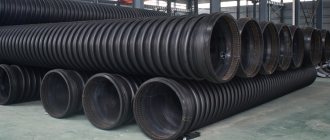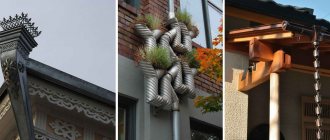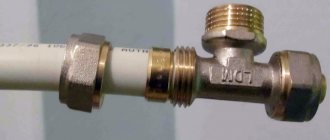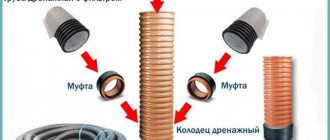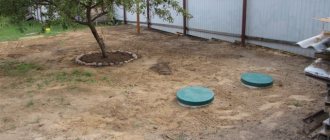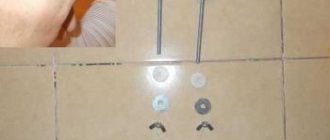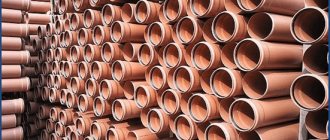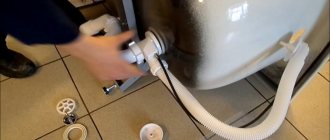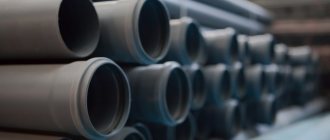You have built your house and are ready to live, enjoying the absence of neighbors behind the wall. But in order for the dream of comfort to become a reality, you should take care of the installation of the drainage system in a timely manner. Otherwise, the building faces constant repairs.
Today, choosing a drainage system is not difficult. The market offers a huge selection of both material and color. It all depends on your needs. Plastic systems are the most popular, which is not surprising; they have many advantages. They are lightweight and you can install them yourself. The question is which of the proposed models to choose. The TechnoNIKOL company has developed the most successful design. The developers took into account consumer requests and achieved high quality.
Main characteristics
The TechnoNIKOL drainage system is made of high quality PVC (polyvinyl chloride). Designed to collect and drain water that collects on the roof after precipitation. The shape of the structure is semicircular (D gutters - 125mm and D pipes - 88mm). Available in several colors. The warranty is given for 15 years.
In addition, this system is distinguished by:
- resistance to temperature changes (from –50°C to +50°C) and ultraviolet radiation;
- simplicity of installation (it’s easy to assemble with your own hands, taking into account the peculiarities of the building);
- light weight;
- versatility (can be used for both new and old buildings of various shapes);
- tightness (provided by rubber seals and snap-on parts);
- linear expansion of the plastic is restored.
The Russian production holding TechnoNIKOL is one of the five leading companies in Europe for the production of waterproofing materials. It has been producing drainage systems since 2011.
How to install a drain correctly?
Installation of the structure, of course, is best left to specialists. However, since the operation is not too complicated, many owners of country houses prefer to carry out the assembly themselves. Do-it-yourself plastic drainage systems are installed as follows:
- The locations of the funnels are determined.
- Next, the brackets are secured. They are usually fixed to the lower roof sheathing on top of the eaves strip. Pre-install two outer hooks - at the highest and lowest points of the gutter.
- A rope is pulled between these brackets, which will serve as a guide for the intermediate hooks. The pitch between elements depends on the weight and size of the system. Usually it is 2-3 meters.
- Laying gutters begins from the lowest point. In this case, each subsequent tray is installed overlapping on top of the previous one. Drain funnels are first secured to the corresponding sections.
- Next, proceed to installing the drainpipe holders.
- After this, the pipes themselves are installed.
Well, we hope that we have to some extent helped you figure out how to choose the right plastic drainage systems for a country house and how to install them yourself. Buy products from trusted manufacturers and follow the installation rules. In this case, the system will be reliable and will last a long time.
What is included in the TechnoNIKOL set
The branded gutter kit includes the following components:
- gutter - guarantees a slope to ensure high-quality water drainage of 1 cm by 3.5 m;
- protective grille;
- drainage drain;
- connecting groove - guarantees the tightness of the connection, thanks to the presence of a rubber seal;
- universal clamp;
- plastic bracket;
- pipe clamp;
- a universal angle allows you to change the direction of the water jet during installation;
- the connecting coupling serves to ensure the tightness of the pipe connection and compensates for expansion under the influence of temperature;
- water intake funnel;
- drain pipe;
- the gutter plug gives it rigidity and tightness;
- universal elbow - used to change the movement of water, go around corners and other architectural decorations of the building.
Marking
Step by step steps:
- Decide where the funnel will be located. It can be installed either in the center of the facade or at the edge. The installation location should be the lowest point.
- Mark the location of the funnel with a pencil.
- Determine the area where the end bracket will be mounted. It is located at a distance of 15 cm from the corner or edge. Mark this area. It is important to start with the outermost bracket, because... this will create the correct slope. This, in turn, will prevent deformation changes.
- Fix the outer bracket 1 cm below the roof slope.
- Measure the distance between the outer bracket and the funnel. Since it will be located at the lowest point, the slope of all gutters is directed towards it.
- Taking into account a slope of 3.5 mm per 1 running meter of the gutter, determine how much lower the funnel should be. For this, the formula is used: number of meters to a given element x 3.5 mm. In our case it turned out to be 7 mm. Mark this place with a pencil.
Instructions for use
Since this drainage system is easy to install, you can handle the installation yourself if you strictly follow the instructions (included in the kit). If you decide to work without the involvement of specialists, it will not hurt to learn some nuances:
- We pay special attention to funnels and their combination with rain grates (water should fall exactly into the center);
- the gutter is located at a distance of 50 - 90 mm from the wall (we count along its inner side);
- First you need to install the front board on the roof.
We determine the places for the drain funnels, and at a distance of 15 cm we strengthen the brackets, first at the corners of the roof. We stretch a rope between them, then install brackets every 60 cm. We lay the gutter (according to the instructions) and check whether it is in contact with the fastenings everywhere, otherwise the load will not flow correctly.
The chute should be installed from the receiving funnel. The connection occurs using couplings with clamps. They need to be latched.
We install an external plug on the gutter. Don't forget to lock the latch. We proceed to the installation of drainpipes. Remember that the funnel pipe must fit into the pipe. The pipes are attached to the wall using clamps. And the last thing: we strengthen the protective grilles in the funnels. Thanks to them, large debris will not fall into the drain. The drain should be located at a distance of 25 cm from the ground, from the blind area - 15 cm.
Now you can evaluate the work and give yourself credit. But for everything to work out, you need to clearly calculate the amount of ingredients. Otherwise, you will have extra “spare parts” and you will complain about your wastefulness. The worst option is that there are not enough components and the design, as they say, is lame.
Metal system
For the manufacture of the main elements, galvanized steel 0.5 mm thick is used. In relation to structures that are operated in unfavorable conditions, an important component is the external coating.
This system is protected from through corrosion by a double-sided polyurethane coating.
Advantages
- Structural elaboration of the elements and originality of the design ensure complete conjugation of pipes and gutters, thereby achieving excellent tightness and minimizing the possibility of damage to the polyurethane layer during installation work.
- The presence of a connector that allows you to install brackets without additional “protrusions”, an outer corner of a rounded shape, a funnel that exactly repeats the shape of the drainage tank - distinguish this system from similar products from other manufacturers, giving it aesthetics, without losing maximum functionality.
- Ease of installation. You can install the drain yourself, following the manufacturer's instructions. The minimum number of brackets and connection parts facilitates quick installation.
- All elements are packaged in polyethylene sleeves, which protects them from external damage during storage and transportation, as well as the adverse effects of external factors.
- Polyurethane coating provides reliable protection of parts from the destructive effects of ultraviolet radiation, precipitation and weather conditions.
Package Included:
- drainage and connecting gutter;
- reinforced mounting bracket;
- external straight and 150 degree adjustable angle;
- 90 degree internal angle;
- funnel;
- universal plug;
- pipe with a diameter of 90 mm, length 1 and 3 meters;
- connecting elbow and pipe outlet;
- a clamp for fixing pipes and a special fastening element with which the clamp is secured to the facade of the building.
To determine exactly how many pipes, gutters, and connecting components will be needed, a previously compiled detailed diagram will help, which will reflect the configuration and total length of the drain.
We count wisely
First of all, we determine the roof area. Armed with a tape measure, taking a pencil and a notepad, we measure the roof area (you can use the building plan). We take into account how much precipitation usually falls in the region. Knowing the roof area and taking into account the configuration of the building, we calculate the number of funnels for drainage.
If the length of the roof eaves is within 12 m, the location of the funnel does not matter. Over 12m – we mount it closer to the center of the cornice. The gap between storm drains is no more than 24 m.
To find out the exact number of gutters, we check the perimeter of the cornice before installation. Now we find out how many pipes will be needed. To do this, measure the distance from the ground to the drain. Having received all the necessary calculations, we estimate the number of components of our drainage system.
Fixing extension cords
If there is no frontal board, you can use metal brackets or extensions for plastic elements. The second option has a hole with risks. Thanks to this, it becomes possible to control the position of the bracket and select the angle of inclination.
Fastening can be done from above the rafters. However, often their pitch does not coincide with the distance of the brackets. Then the straight extension is fixed in OSB-3 in a pre-made cut.
Step by step steps:
- Make cuts on the roof.
- Bend the metal elements to the angle of the roof with a special tool.
- Fix the extension in the cut.
- Attach the bracket to it.
If the roof has not yet been installed, straight extensions are used.
If the roof is already done, then the sides. They are fixed to the side of the surface of the rafter leg. This extension is convenient when reconstructing a roof when there is no frontal board.
We check
We use a building level or a level to check the slope of the gutter. To make sure the structure is tight, you need to plug the drain, pour water into the gutter and wait to see if a leak appears. Now you need to unblock the drain and see how long it takes for the water to drain and whether it remains in the gutter.
How correctly the gutters are installed at the edge of the roof is checked with a lath. It should fit easily under the gutter. If it resists, it means a mistake has been made. You can check for overflows using a watering hose. To do this, we orient the hose with water towards the roof slope. If the water does not overflow, you have done everything correctly. The water pressure should be average.
Funnel installation
This part is necessary to connect the gutter to the pipe for water drainage.
The funnel is attached to self-tapping screws through pre-drilled holes.
If there is no frontal board, then this element is fixed to extensions.
For 50 sq. m. it is necessary to install 1 funnel. At least one element must be on the slope.
Don't skimp on the little things
A number of reasons lead to the short service life of plastic gutters. And chief among them is excessive savings. This can lead to a lack of elements, and as a result:
- few funnels (water overflows from them and from the gutter);
- the gap between the brackets is large (the gutter bends under the weight of precipitation);
- mounting clamps for pipes are installed far from each other (they will not stand in strong winds);
- the drainpipe is located on the corner of the building (it will fall off in strong winds);
- the pipe “lies” on the wall (the wall may collapse over time, as well as the foundation and base).
The tool for the job should be selected in advance. To install a TechnoNIKOL drain you will need: a building level, a drill, a plumb bob, a utility knife, an angle grinder or a hacksaw, and a hammer drill.
You might be interested in this:
- Installation instructions for the Grand Line metal drainage system
- Installation instructions for the Aquasystem copper roof drainage system
- DIY installation instructions for the Deke Lux drainage system
Peculiarities
TechnoNIKOL is a modern material that is used for covering roofs, installing and installing drainage structures. A distinctive feature of the material itself is its lightness. You won't have to worry about making the system too heavy. But at the same time, there is no need to fear that the material will be short-lived against this background. It is completely resistant to external mechanical damage (be it a hail strike or prolonged pressure from a snow mass), as well as to climate changes (plus or minus 10-15⁰C will in no way affect the condition of the material).
In addition, the material has excellent hydro- and sound insulation. Any installation using TechnoNIKOL provides complete insulation of noise, extraneous influences, and moisture.
Knee
A universal elbow is necessary to change the water flow. If there is a cornice overhang, the pipe and funnel are connected by these two elements and a piece of pipe cut to the required length.
Step by step steps:
- Insert the knee into the funnel.
- Install a piece of pipe into the elbow that will lead the structure to the wall.
- Place another knee.
- Connect the structure to the pipe.
- Install a clamp on the lower elbow. Fix it to the wall with self-tapping screws.
If there is no eaves overhang, the funnel and pipe are connected using a coupling or directly.
There is also a two-knee bend combination. This is a connection of a funnel and a vertical pipe with two elbows, without using a segment. This method is used when the eaves overhang is short.
Wall swivel sill
This element is intended to protect the facade at the junction of the roof. It is in this area that water most often damages the roof.
If the slope ends up adjacent to the wall, the ebb is inserted under the shingles and underlayment.
A valley carpet with flexible tiles is laid. It is he who will fix the element.
This completes the installation. When carrying out work, it is important to take into account that installation must be carried out in accordance with all rules, in stages. In addition, the system requires regular maintenance. This will ensure a long service life.
Device
Drainage structures on flat roofs are equipped in two types:
Gravity
Sediment is collected and freely discharged through gutters installed with a slope. However, the pipes are not completely filled with water.
Siphon
The main principle of their operation is the complete filling of the drainpipe with sediment, as well as the formation of a water column, originating at the water intake and ending near the external outlet of the flow
When the precipitation level decreases, liquid is forced to be sucked from the receiver into the riser. This method is considered more effective than gravity
, however, for it to work all the time, careful sealing of all joints is required
due to the exact match of the diameter
of the pipes used, as well as the use of those materials with which high-quality sealing can be achieved.
A characteristic feature of siphon structures is the presence of flow stabilizers. They help direct water and prevent air from entering the system, which is usually installed using the butt welding method.
The advantages of this design are obvious and are that:
- in case of light precipitation it can work as gravity flow, and in case of excess melt or rain water it perfectly eliminates it;
- its installation requires fewer water intakes and risers than for gravity flow, and the pipes used can be smaller in cross-section, which reduces costs
; - Due to the rapid movement of sediments, the system can self-clean.
On a flat roof, the main function of collecting and receiving water is assigned to the funnel. Typically such a device consists of:
- a cover covering the top of the product;
- grates that protect the drain from contamination by foreign objects and debris;
- a ring that makes the funnel sealed;
- water receiving bowl, from where water is redirected to the drain;
- release - a special fitting located horizontally or vertically.
The kit also includes an oil seal that helps seal the outlet with the drainpipe, a flange or bolt with which the water receiver is secured.
Installing a protective grille
If leaves and debris get into the gutter, water will have difficulty moving through it. As a result, it will overflow, the walls will become wet, and the foundation will be washed away. To prevent this, the top of the gutter must be covered with a protective grille with a gripping system with small spikes on the convex surface. The element is mounted in the gutter until it clicks.
Pipe clamp
The pipes are fixed to the wall with clamps. When the pipe needs to be fixed at a significant distance from the facade, a universal element is used.
Step-by-step installation:
- Install fasteners. It is selected depending on the indentation and the thickness of the insulation. In this case, it must extend into the surface by at least 5 cm. Dowels of 140 and 180 mm are supplied with the clamp.
- Screw the clamp onto the fastener and place it on the pipe.
- Tighten all bolts so that the pipe does not move. It is important to take into account that the compression should not be too strong.
- The step between clamps must be at least 1.5 m.
